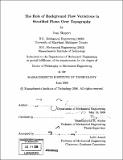| dc.contributor.advisor | Triantaphyllos R. Akylas. | en_US |
| dc.contributor.author | Skopovi, Ivan, 1976- | en_US |
| dc.contributor.other | Massachusetts Institute of Technology. Dept. of Mechanical Engineering. | en_US |
| dc.date.accessioned | 2008-02-12T16:50:41Z | |
| dc.date.available | 2008-02-12T16:50:41Z | |
| dc.date.copyright | 2006 | en_US |
| dc.date.issued | 2006 | en_US |
| dc.identifier.uri | http://hdl.handle.net/1721.1/35632 | |
| dc.description | Thesis (Ph. D.)--Massachusetts Institute of Technology, Dept. of Mechanical Engineering, 2006. | en_US |
| dc.description | Includes bibliographical references (leaves 89-91). | en_US |
| dc.description.abstract | As the atmosphere and oceans feature density variations with depth, the flow of a density-stratified fluid over topography is central to various geophysical and meteorological applications and has been studied extensively. For reasons of convenience and mathematical tractability, the majority of theoretical treatments of stratified flow over a finite-amplitude obstacle assume idealized background flow conditions, namely constant free-stream velocity and either a homogeneous or two-layer buoyancy-frequency profile. In this work, a numerical model is developed that accounts for general variations in the buoyancy-frequency profile far upstream and the presence of unsteadiness in the free-stream velocity. The model employs a second-order projection method for solving the Euler equations for stratified flow over locally confined topography in a horizontally and vertically unbounded domain - the flow configuration most pertinent to atmospheric applications - combined with absorbing viscous layers at the upper and lateral boundaries of the computational domain. Using this model, a study is first made of the effect of variations in the buoyancy frequency on the generation of mountain gravity waves. | en_US |
| dc.description.abstract | (cont.) Balloon measurements reveal that, apart from a sharp increase (roughly by a factor of 2) at the so-called tropopause, atmospheric buoyancy-frequency profiles often feature appreciable oscillations (typical wavelength 1-2 kni). It is found that such short-scale oscillatory variations can have a profound effect on mountain waves owing to a resonance mechanism that comes into play at certain wind speeds depending on the oscillation length scale. A simple linear model assuming small sinusoidal buoyancy-frequency oscillations suggests, and numerical simulations for more realistic flow conditions confirm, that the induced gravity-wave activity under resonant conditions is significantly increased above and upstream of the mountain, causing transient wave breaking (overturning), similarly to resonant flow of finite depth over topography. The effect of temporal variations in the free-stream velocity is then explored for a range of amplitudes and periods typical of those encountered in the field. The simulations reveal that transient disturbances resulting from such variations can be significant, particularly in the nonlinear regime, and steady states predicted on the assumption of uniform wind may not be attainable. | en_US |
| dc.description.statementofresponsibility | by Ivan Skopovi. | en_US |
| dc.format.extent | 91 leaves | en_US |
| dc.language.iso | eng | en_US |
| dc.publisher | Massachusetts Institute of Technology | en_US |
| dc.rights | M.I.T. theses are protected by copyright. They may be viewed from this source for any purpose, but reproduction or distribution in any format is prohibited without written permission. See provided URL for inquiries about permission. | en_US |
| dc.rights.uri | http://dspace.mit.edu/handle/1721.1/7582 | |
| dc.subject | Mechanical Engineering. | en_US |
| dc.title | The role of background flow variations in stratified flows over topography | en_US |
| dc.type | Thesis | en_US |
| dc.description.degree | Ph.D. | en_US |
| dc.contributor.department | Massachusetts Institute of Technology. Department of Mechanical Engineering | en_US |
| dc.identifier.oclc | 76288313 | en_US |
